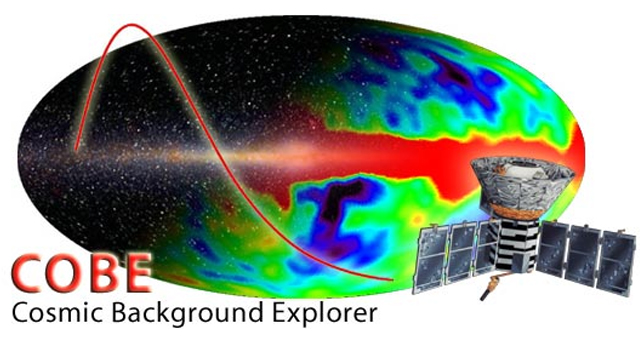Stories
Measuring the Big Bang with the COBE satellite

The Cosmic Background Explorer satellite (COBE) went up on a Delta rocket on Nov. 18, 1989, into a polar sun-synchronous orbit 900 km up. Our team at NASA Goddard Space Flight Center (GSFC), Ball Aerospace, the Jet Propulsion Laboratory (JPL) and universities built it to look at the cosmic microwave and infrared background light that comes to us from the distant universe, so far away that it seems to be a nearly uniform glow. With it, we started the new subject of precision cosmology; before the COBE very little was known except the general idea of an expanding universe, misnamed the Big Bang. (It’s misnamed because the name conjures up the image of a firecracker, happening at a place and a time. Astronomers see an infinite universe expanding into itself, with no center, no edge and no first moment.)
Our team measured the spectrum of the cosmic heat ― more precisely the cosmic microwave background radiation― left over from times when the universe was compressed and hot, with a precision of 50 parts per million. The prediction was for a nearly perfect blackbody spectrum, and it matched. No other story of the universe was ever able to explain that. We also found the hot and cold spots of the heat radiation, known as anisotropy (Greek for not the same in every direction). Stephen Hawking said that was the most important scientific discovery of the century, if not of all time.
Now we know that: a.) the spots are responsible for our existence, because gravity acting on the regions of higher density was able to stop the matter from expanding; b.) most of the spots are caused by dark matter; and c.) if we ever know what made the spots, we might understand quantum gravity. In 2006, I got a call from Stockholm, and the Nobel Prize in Physics went to me and to George Smoot in recognition of the work of our team. Now the entire world knows what we know: it was really important.
We started in 1974, just 5 years after the first Apollo landing on the Moon, when NASA announced opportunities to propose new satellite missions. I had just finished my thesis project in January and taken a job with NASA’s Goddard Institute for Space Studies in New York City to become a radio astronomer. My thesis project at the University of California, Berkeley, was intended to measure that cosmic background radiation, but it failed to function properly. Yet only months after my arrival in New York, NASA announced the opportunity. My advisor Pat Thaddeus knew what to do: call up our friends and write a proposal. (One of those friends is Rainer Weiss of the Massachusetts Institute of Technology, who was also working on gravitational wave detection. He shared the 2017 Nobel Prize for detecting gravitational waves from merging black holes.)
I never expected our proposal to be chosen, but it was, thanks to far-seeing people at Headquarters like Nancy Boggess, and NASA created a new science team including people from two competing teams. Anticipating that choice, Mike Hauser recruited me to Goddard in Greenbelt, Maryland, and I was hoping to become the lead scientist. Soon Goddard assigned a brilliant team of engineers, who were just completing the IUE observatory, to help us along. We built up a team that eventually included 1,500 contributors, including a science team of 19 spread around the country.
The project was extraordinarily challenging, and became the largest in-house project Goddard has ever done. We brought the work in, because we were pushing so far beyond known engineering that it was impossible to write a contract specification; I spent much of my life in the offices of engineers seeking approaches to doing the impossible. I trusted my future to them, and they to me. In the end, our mission worked beautifully, after many changes, including a redesign after the Challenger loss made it clear we would not be launched on the shuttle.
NASA and its partner agencies like the European Space Agency and Canadian Space Agency are the only places in the known universe where space science and space engineering meet so intimately, where engineers build what has never been built before, so scientists may discover what has never been known before. I can only marvel at the works we have done, and imagine what we may yet do together.
